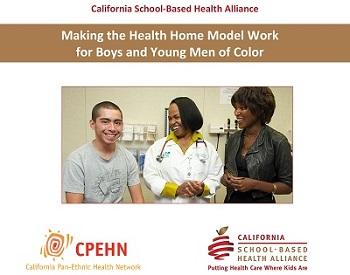
This week the California Pan-Ethnic Health Network (CPEHN) and the California Schol-Based Health Alliance released a new brief, Making the Health Home Model Work for Boys and Young Men of Color, to examine how we can tailor our health system to meet the needs of boys and young men of color.
Imagine you’re a young African American man living in Oakland. Depending on where you live, you might face multiple challenges every day that impact your quality of life. You might wake up to gun shots or violence in your neighborhood. You might walk to school over broken or nonexistent sidewalks. You might have outdated textbooks in your classroom when you are trying to learn. You would be 25 times more likely to have one of your classmates be the victim of homicide than your White peers. You’d also be more likely to say that you feel your overall health to be fair to poor.
Boys and young men of color often bear the brunt of institutional racism and violence in many ways. And instead of seeing images of national heroes that look like them in the media, they are plagued by stories of Trayvon Martins and Michael Browns killed by senseless violence. This disproportionate exposure to violence and trauma has a tremendous impact on these young men’s physical and mental health and wellbeing. And it must stop. Now more than ever we must identify approaches that address health issues and disparities for future generations of African-American, Asian and Pacific Islander, Latino, and Native American boys and young men of color.
With the implementation of the Affordable Care Act, millions of formerly uninsured now have access to health coverage, and the health care system is shifting to a more patient-centered approach, mostly through the health home model. While this is a great way to improve health, we need everyone to benefit from these improvements, particularly vulnerable boys and young men of color who face challenges day in and day out that impact their wellbeing. That’s why the California School Based Health Alliance and CPEHN have developed Making the Health Home Model Work for Boys and Young Men of Color, a new brief that examine how this model can better meet the unique needs of this population.
The patient-centered health home model can play a role as a trusted source of care for these young men, who often do not see the health care system as being able to meet their needs. Designed around the patient’s specific needs, this model uses a coordinated team of service providers to strengthen relationships with health care providers, increase access, and improve health outcomes. Making the Health Home Model Work for Boys and Young Men of Color is framed around two primary goals: the need to meet the needs of boys and young men of color so that the health home model works for them, and the need to commit to thinking about how to serve this population and take that first step to improve services.
This is a vital time for our future generations. We need to make sure that no populations are left behind in our efforts to create healthier communities. Boys and young men of color need more opportunities to lead safe, healthy lives, and the patient-centered health home model can be a step toward ensuring they get that chance.
Sarah de Guia is the Executive Director of the California Pan-Ethnic Health Network.


The views and opinions expressed in this post are those of the author(s) and do not necessarily reflect those of MomsRising.org.
MomsRising.org strongly encourages our readers to post comments in response to blog posts. We value diversity of opinions and perspectives. Our goals for this space are to be educational, thought-provoking, and respectful. So we actively moderate comments and we reserve the right to edit or remove comments that undermine these goals. Thanks!